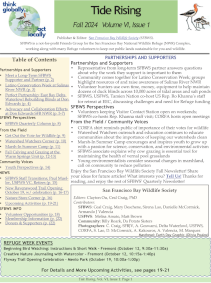S.F. Baylands Report Urges Working With Nature
- via a press release from the California State Coastal Conservancy.
In a recently released report, over 200 scientists and government officials propose a new approach to manage the challenge of sea level rise in San Francisco Bay: Work with nature, rather than against it, to protect homes, businesses, and shoreline communities from sea level rise, extreme storms, and flooding.
The report, “The Baylands and Climate Change: What We Can Do,” presents the latest science and new findings on the health and future of the bay’s shore. It assesses the biggest threats and suggests a science-based roadmap to protect our communities with more resilient shorelines.
“This report tells us what we must do today to ensure a healthy San Francisco Bay for our children’s future,” said Sam Schuchat, Executive Officer, State Coastal Conservancy, which commissioned the report on behalf of a 21-member group of regional science, conservation, and government entities. “If we have the courage to act now and follow these scientific recommendations, we can secure much of what is most precious about living in the Bay Area and ensure the gratitude of future generations.”
Instead of relying only on levees and sea walls, the report suggests ways to use wetlands along the shore to buffer the seven million people living in the Bay Area from rising seas and extreme storms. Wetlands knock down large waves, absorb excess water, filter pollutants, provide habitat for wildlife and places for people to enjoy the outdoors, and are part of the iconic beauty of San Francisco Bay.
“The people of the Bay Area rely on these wetlands for shoreline protection and many other benefits and yet have no idea that in a few decades they may start to disappear.Now is the moment to realize that we need to actively change how we manage our landscapes to keep this critical natural infrastructure in place and supporting our quality of life,” said Letitia Grenier, lead scientist for the project, of the San Francisco Estuary Institute.
“Rising seas, more extreme weather events, and other impacts of climate change are already altering our region’s ecosystems. This will accelerate in coming decades,” said Carl Wilcox, California Department of Fish and Wildlife, project co-chair and contributing author of Baylands Ecosystem Habitat Goals report (1999). “By using new scientific knowledge and tools, this report provides a roadmap for visionary management. This document provides a vital basis to sustain the iconic beauty and valuable services of our remarkable baylands for future Bay Area residents.”
Given the importance of wetlands to the future of the Bay Area, the report lays out bold and immediate approaches for maintaining a healthy bay shore:
* Work with nature, not against it. Protect existing wetlands and help them grow to keep pace with sea level rise. Wetlands are self-maintaining and can be a resilient buffer against sea level rise and storms, if we allow the natural processes of water and earth that nourish them to occur. The alternative is sea walls and levees that require ongoing, expensive maintenance and none of the other benefits of wetlands.
* Sediment [earth] is essential to grow and sustain our wetlands.A major threat to S.F. Bay wetlands is a lack of sediment in the bay for sustaining their growth. Wetlands can keep up with rising seas only if sediment builds up along the surface of a marsh over time. This needed sediment can come from dredging of shipping and flood control channels, natural flows carried by streams, and other sources.Agencies have an opportunity to bring sediment to wetlands instead of dumping it in the ocean or in landfills.
* Remember our streams. One solution to rising bay waters is in our own backyards—managing our land and streams to deliver sediment and clean water to nourish marsh growth. It’s time to work with the entire watershed system, from the hills to the bay.
* Start today. Time is a key factor. An accelerated effort could save over 80% of our existing wetlands over the next 100 years.
“These updated findings provide an urgently needed roadmap to secure the future of the San Francisco Bay shore during this time of rapid change,” said Ellie Cohen, President and CEO, Point Blue Conservation Science; co-founder, Bay Area Ecosystems Climate Change Consortium. “Produced by leading scientists, managers, and decision makers, these practical, climate-smart recommendations will guide wetlands restoration and watershed management to sustain wildlife and people for decades to come.”
“Around the world, it’s the low income and disadvantaged communities who suffer the most from climate change,” said Assembly member Tony Thurmond (AD-15). “Here, in the Bay Area, it will be the lower income communities, ‘in the flats’ who will take the biggest hit from sea level rise and shoreline flooding.As we plan for sea level rise, let’s make sure our decisions give priority to the most vulnerable and disadvantaged communities.”
“The recommendations provided by over 100 of the region’s leading scientists are invaluable for helping managers, scientists and decision-makers continue to make progress in restoring and maintaining our valuable wetlands,” added Michael Monroe, lead author and project co-chair for the Bayland Ecosystem Habitat Goals report (1999). “We now know we must accelerate our restoration efforts, and adopt new watershed and in-bay management practices to ensure there is sufficient sediment for the baylands to continue to provide a multitude of beneficial functions in the face of rising seas.”
For more information and to review the report, visit www.baylandsgoals.org
California State Coastal Conservancy • 1330 Broadway, 13th Floor • Oakland, CA 94612-2530


